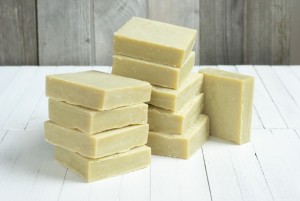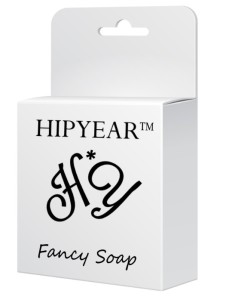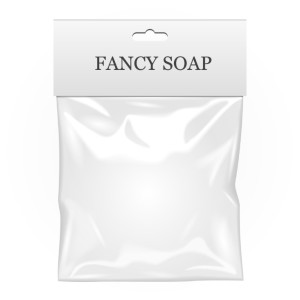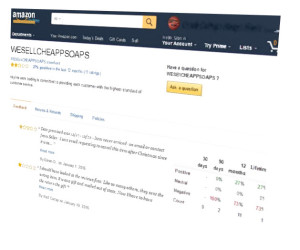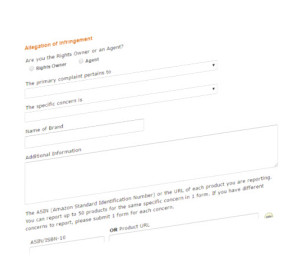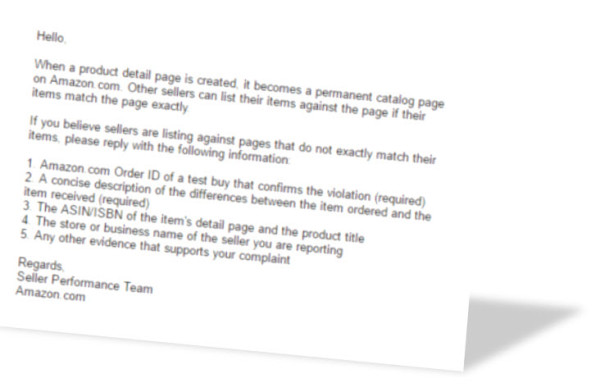Private-Labeled Goods on Amazon.com: Protecting Your Trademarks and Defending Against Listing Hijacking

By: Eric Perrott, Esq.
Amazon can be a cut-throat marketplace where winners and losers are decided by razor-thin margins. Amazon retailers battle each other selling well-known brands’, trying to find a lead on a supplier that can offer them better prices in order to undercut a competitor selling those same branded products. Often sellers wish they could just have a listing to themselves and sell their own products under their own brand name. Today, through the practice of “private-labeling,” it is more achievable and affordable than ever to start a product line. “Private-labeling” (or “white-labeling”) is when a trademark owner applies its trademark to an unbranded, generic product and sells it under their trademark name. This practice allows Amazon sellers to “stake a claim” in a product and, through the sellers’ excellent customer service, quality control, and personal style and taste, allows sellers to build a brand from the bottom up and be rewarded with a strong trademark and a branded product not available anywhere else.
This practice has its significant risks and pitfalls, however. It takes work, talent, and perseverance to create a success private-labeled brand. It also takes a keen knowledge of United States trademark law to ensure that a brand is protectable and worth the time and monetary investment. Also, inevitably, with every successful brand selling private-labeled products is a counterfeiter selling a similar, inferior product waiting to unfairly profit from the brand owners’ hard work. However, through both preventative and offensive steps towards trademark protection, a trademark owner can effectively manage its brand and be in the position to quickly dispose of counterfeiters before the trademark owner’s trademarks are permanently harmed.
This article will discuss the use of trademarks on private-labeled goods in three parts.
Part 1: The Private-Labeling Process will discuss what is (and is not) a private-labeled product and best practices when getting started.
Part 2: Amazon Infringers, Counterfeiters and Hijackers will discuss the most typical form of infringement a private-labeled product seller is likely to encounter on Amazon.com.
Part 3: Going on the Offensive: Enforcement Letters & Take-Down Notices will discuss various strategies for dealing with infringers, counterfeiters and hijackers.
Part 1: The Private-Labeling Process
With private-labeled goods, it is important to understand exactly what that means in the context of Amazon. Amazon is built to be extremely friendly to resellers in order to offer consumers the lowest possible price. Let’s say that you are an Amazon seller and want to gain rights in the mark HIPYEAR™ for soap. If you simply buy, for example, 1000 bars of Dove® soap from a distributor, you cannot put the Dove® soap in a baggy with HIPYEAR™ on it to make it HIPYEAR™ Soap and expect to have a protectable trademark for “soap.” If you consistently use HIPYEAR™ as your seller name and on your Amazon storefront, you may be able to stop other sellers from using a similar name as their store name. You cannot, however, claim trademark rights in HIPYEAR™ for soap, because you are a reseller, not a private-label-brand seller.
Private-labeled goods should not have any identifying trademarks from the manufacturer that would lead consumers to believe that the manufacturer (as opposed to the trademark owner) is the source of the product. Instead, the private-labeled goods must be clearly marked with your trademark.
Let’s go back to the fictional HIPYEAR™ trademark. Let’s say you have also sourced a high-quality soap maker in France that sells bulk, unbranded soap and purchase one thousand units. Important: Always keep in mind that your sales contract will dictate certain ways that the product may be sold and used, so ensure that you’re not violating any contract terms by private-labeling these goods. If you purchase products and sell them in any way that violates your purchase agreement, you may be liable for damages.
While finalizing your purchase order, you would have had a professional perform a comprehensive clearance search on the trademark and had an attorney draft and file the trademark application to reserve your rights. If you haven’t gotten to this step yet, stop right now and do it. We have had sellers skip this step, only to either (1) receive a cease-and-desist letter in the mail based on another trademark owner’s prior rights in a confusingly similar mark, or (2) try to enforce their trademark rights against infringers, counterfeiters, and hijackers and hit road-block after road-block, costing them sales and permanently damaging their trademark. In one case, we even had a counterfeiter apply to federally register the trademark the seller was actively counterfeiting. A search and federal registration is essential to building a brand and should not be delayed for any reason.
Your trademark has been cleared, you applied for a federal registration and you’ve designed boxes for your products with the HIPYEAR™ trademark and HY logo (see fictional example, left). You and your trusty team check for any defects in the products, assemble and stuff the boxes, and apply your barcode and UPC. You then take stunning photographs (which you remember to file federal copyright applications for within three months of posting them to Amazon) and create a new listing on Amazon.com. A couple days later, you get your dozen first sales from real customers.
Congratulations, at its most basic, you have begun legitimate trademark use of a private-labeled product.
With every sale of HIPYEAR™ soap, customers are attaching meaning to the trademark. In the customers minds, HIPYEAR™ stands for the product’s quality, whether that’s your taste in picking out a nice scent or whether it’s your quality-control practices to ensure no customer will get a defective bar of soap. This is immediately reflected in your product reviews, but your trademark now has an impact on every single buyer who sees it. This is invaluable, because now your trademark, formerly just words on a box, have meaning to a consumer.
Now that you have a trademark on your private-labeled product, what happens when someone else tries to copy it on Amazon?
Part 2: Amazon Infringers, Counterfeiters and Hijackers
Part 1 of this article discussed how to effectively utilize a trademark with private-labeled goods. Throughout this article, we are using the fictional brand HIPYEAR™, a trademark used on fancy soaps, to discuss the potential pitfalls for trademark owners selling private-labeled goods on Amazon. If you already think that you are effectively private-labeling your products with your trademark and skipped Part 1, I highly recommend you read it, if, for nothing else, context on the bigger picture. As in all of the articles you read on this site, this is not meant to be legal advice. You should talk to a lawyer with questions about your specific legal issues.
With every successful private-labeled product Amazon listing, there lurks another seller intent on benefiting from the trademark owner’s hard work. One of the difficulties in utilizing private-labeled products is that the trademark owner typically cannot apply its brand to the actual product itself and must, therefore, effectively utilize it on the product packaging. As a result, it can be fairly easy for someone else to source goods that look very similar to the actual product being sold under an Amazon seller’s trademark. In some cases, the generic underlying product itself may even be from the same bulk-goods manufacturer. This is one of the risks sellers take when they offer private-labeled brands—someone else may be selling the same underlying product under a different brand name. While more expensive, custom products can overcome this problem, as buying custom products from manufacturers involves forming exclusive relationships with a manufacturer to make exclusive products for only one seller. The seller does not have to worry about a competitor selling products from the same manufacturer and does not have to create custom formulas or custom molds.
However, just because a seller sells a similar (or in rare cases, identical) source product this does not mean that a seller can list and sell its product under someone else’s trademark. If sellers attempt to pass off their products as the genuine-branded product, they may be liable for trademark infringement and/or counterfeiting. However, this is a common, frustrating practice among some Amazon sellers and can be dealt with through effective defensive protection and offensive enforcement.
This is a practice we call “Amazon listing hijacking,” where an Amazon seller will see that a product is selling well and is well-reviewed and will attempt to buy similar generic products to sell under the genuine brand listings.
In the HIPYEAR™ example, imagine that you have gotten excellent reviews and are rocketing to the top of the “fancy soap” category in Amazon with 80 five-star reviews. Suddenly you notice a dip in your numbers and you open your listings to find a seller named WESELLCHEAPPSOAPS alleging to sell HIPYEAR™ soap for two dollars less than your original listing. The “buy-box” goes to that seller and customers are now purchasing those fake goods instead of yours. Imagine that customers who ordered from WESELLCHEAPPSOAPS get a clear plastic baggy with the words FANCY SOAP on it (see fictional packaging, right) instead of legitimate HIPYEAR™ packaging.
Next, you start to see poor reviews about your product with unflattering pictures of packaging that is clearly not yours. Your trademark is now no longer under your control and this is dangerous because, once a customer gets a bad impression about a trademark, you cannot “unring the bell.” The harm that is done to your brand is likely irreparable, as you may never get another chance to change the consumer’s impression of your brand in his or her mind.
You now need to enforce your trademark rights against those sellers. Part 3 of this series will discuss the various techniques for dealing with infringers, counterfeiters and listing hijackers.
Part 3: Going on the Offensive: Enforcement Letters & Take-Down Notices
Part 1 & Part 2 of this article discussed the creation of a private-labeled product and the resulting trademark rights, as well as identifying infringers, counterfeiters and Amazon listing hijackers on your listings. Part 3 will discuss how to enforce your trademark rights against those sellers. I encourage you to read both Part 1 & 2 for the proper context and, as always, this is not meant as legal advice. You should discuss your specific legal issues with an attorney.
When a trademark owner first notices an infringer, his or her first instinct will likely be to lash out. This may include sending angry e-mails (often filled with typos and profanity), filing fake bad reviews to the infringing seller’s accounts and to its other listings (which may result in the trademark owner’s account being suspended) and drafting hasty take-down notices to Amazon (which do not likely include the legal analysis or proper steps to be successful).
Sellers need to fight these urges. What may be an emotional outburst now may be the next embarrassing viral hit on social media, or, worst, may be the deciding factor to a judge or jury regarding liability for any number of potential claims.
The best way to proceed is to take a deep breath, start to analyze the situation and start gathering evidence. Take date-stamped screenshots of the listings and gather all of the information you can through public sources about the seller. Note any phone numbers or addresses provided by the seller on its seller profile and note the number of sales and reviews the seller has (see seller profile example, right) Think of the legal claims—is this really a trademark issue? Is it a copyright issue? Think of the possible defenses—did you ever sell a stock of these products to a reseller? Could this be a legitimate seller? If you have trouble effectively answering any of these questions, then immediately call an attorney who knows how to deal with Amazon intellectual property issues to discuss.
The next steps will vary widely from trademark owner to trademark owner and will vary from seller to seller depending on the facts of each matter. Depending on the facts and legal analysis, the next steps will likely involve either an enforcement letter or a take-down notice. Sometimes the best route may be to send an enforcement letter giving the seller a chance to remove the infringement without suffering consequences from Amazon. Keep in mind that enforcement letters and take-down notices are serious legal matters and should not be sent lightly. If for any reason the claims are not on solid legal ground, it could open the trademark owner up to legal liability under several different claims. It also opens up the trademark owner to being judged in the “court of public opinion” if the claims are posted and publically scrutinized. We’ve written in the past about the anatomy of an enforcement letter and a trademark owner should always consult an attorney before making legal claims against another party.
An Amazon take-down notice, while time-consuming, can be a serious deterrent to sellers, as each take-down notice may lead to suspension or termination of a seller’s Amazon account. If an enforcement letter has already been sent and was not successfully, a take-down notice with Amazon is likely the next step. In some matters, the legal strategy may be to jump directly to the take-down notices, especially if, for example, this is a repeat infringer who has been warned in the past or if the products in question are particularly expensive.
In order to process a trademark take-down notice, Amazon requires a test-purchase to prove that the alleged counterfeit is, indeed, a non-genuine product. From a legal standpoint, it is important to make sure that each test purchase is treated as if it were going to be used as evidence in court. While 99.9% of the time it won’t be, utilizing a detail-oriented mindset will ensure that all of the evidence is clearly documented and supports the trademark owner’s claims. This is another place where an attorney may more effectively guide the process. For example, we use a trademark investigator to purchase all products and write a detail report with pictures. That investigator then provides this information to us for legal analysis and review. We then make that the report is available to Amazon when we submit our take-down notices with our legal claims.
Once a take-down notice is filed, additional follow-up is often needed. For any number of reasons, Amazon’s first-level customer service representatives may reject a trademark owner’s take-down notice without clearly stating why the take-down was rejected. This is where a detailed response with supporting evidence is essential. Amazon, once they have sufficient evidence that a product is non-genuine, will remove the seller from the listing.
Private-labeling products is a cost-effective way to start building the goodwill in a trademark. Along with the benefits, however, come serious risks. Diligence is required to effectively police a trademark and defend against Amazon listing hijackers and infringers. New hijackers are getting started every day as the pressure mounts on Amazon to come up with a better way to protect against the rampant counterfeiters on in its marketplace. Still, through effective registration, analysis and enforcement of its trademarks, trademark owners can effectively protect their valuable intellectual property.
This blog does not provide legal advice and does not create an attorney-client relationship. You may not rely on any information in this article as legal advice. If you need legal advice, please contact an attorney directly.
Do you need assistance with a trademark matter?
Contact an Attorney Today
